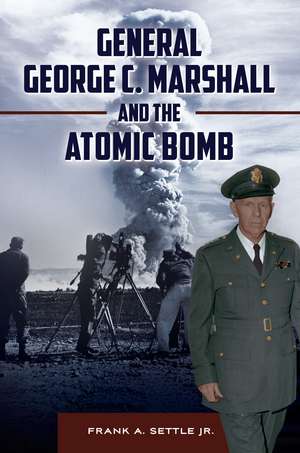General George C. Marshall and the Atomic Bomb
Cuvânt după de Robert Strong Autor Frank A. Settle Jr. Cuvânt înainte de Robert Norrisen Limba Engleză Hardback – 17 apr 2016 – vârsta până la 17 ani
Preț: 356.46 lei
Preț vechi: 415.52 lei
-14% Nou
Puncte Express: 535
Preț estimativ în valută:
68.21€ • 71.36$ • 56.66£
68.21€ • 71.36$ • 56.66£
Carte tipărită la comandă
Livrare economică 03-17 aprilie
Preluare comenzi: 021 569.72.76
Specificații
ISBN-13: 9781440842849
ISBN-10: 1440842841
Pagini: 264
Ilustrații: 12 bw illus
Dimensiuni: 156 x 235 x 16 mm
Greutate: 0.54 kg
Editura: Bloomsbury Publishing
Colecția Praeger
Locul publicării:New York, United States
ISBN-10: 1440842841
Pagini: 264
Ilustrații: 12 bw illus
Dimensiuni: 156 x 235 x 16 mm
Greutate: 0.54 kg
Editura: Bloomsbury Publishing
Colecția Praeger
Locul publicării:New York, United States
Caracteristici
Documents Marshall's role in pulling together the financial, material, and human resources required for the Manhattan Project as well as his collaboration with Secretary of War Henry Stimson and Manhattan Project leader General Leslie Groves to produce the atomic bomb
Notă biografică
Frank A. Settle Jr., PhD, professor emeritus of chemistry, Washington and Lee University, and director of the ALSOS Digital Library for Nuclear Issues, was professor of chemistry at the Virginia Military Institute from 1964 to 1992.
Cuprins
Foreword by Robert NorrisPrefaceAcknowledgmentsChapter One The BeginningsChapter Two The Discovery of Fission and Einstein's LetterChapter Three Marshall and the Geneses of the Manhattan ProjectChapter Four Organizing the Manhattan ProjectChapter Five Intelligence OperationsChapter Six Uncertainty, the Bomb, and the Interim CommitteeChapter Seven Unconditional Surrender and a Planned InvasionChapter Eight Potsdam and TrinityChapter Nine Japan's Response to the Potsdam Declaration, Hiroshima, and NagasakiChapter Ten Japan SurrendersChapter Eleven A New AgeChapter Twelve Marshall as a Diplomat: Secretary of StateChapter Thirteen The Final Call to Duty: Secretary of DefenseAfterword by Robert StrongAppendicesA. Tube Alloys (S-1) Organization ChartB. Manhattan Project Organization ChartC. Decision to Use the Atomic BombD. Fateful Spring and Summer of 1945Abbreviations and Code NamesNotesBibliographyIndex
Recenzii
A tightly focused, generally well-written analysis for major public and, especially, university libraries. Summing Up: Highly recommended. All levels/libraries.











